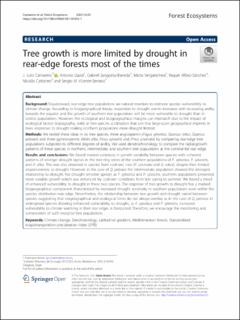| dc.description.abstract | Background Equatorward, rear-edge tree populations are natural monitors to estimate species vulnerability to climate change. According to biogeographical theory, exposition to drought events increases with increasing aridity towards the equator and the growth of southern tree populations will be more vulnerable to drought than in central populations. However, the ecological and biogeographical margins can mismatch due to the impact of ecological factors (topography, soils) or tree-species acclimation that can blur large-scale geographical imprints in trees responses to drought making northern populations more drought limited. Methods We tested these ideas in six tree species, three angiosperms (Fagus sylvatica, Quercus robur, Quercus petraea) and three gymnosperms (Abies alba, Pinus sylvestris and Pinus uncinata) by comparing rear-edge tree populations subjected to different degrees of aridity. We used dendrochronology to compare the radial-growth patterns of these species in northern, intermediate, and southern tree populations at the continental rear edge. Results and conclusions We found marked variations in growth variability between species with coherent patterns of stronger drought signals in the tree-ring series of the southern populations of F. sylvatica, P. sylvestris, and A. alba. This was also observed in species from cool-wet sites (P. uncinata and Q. robur), despite their limited responsiveness to drought. However, in the case of Q. petraea the intermediate population showed the strongest relationship to drought. For drought-sensitive species as F. sylvatica and P. sylvestris, southern populations presented more variable growth which was enhanced by cool-wet conditions from late spring to summer. We found a trend of enhanced vulnerability to drought in these two species. The response of tree growth to drought has a marked biogeographical component characterized by increased drought sensitivity in southern populations even within the species distribution rear edge. Nevertheless, the relationship between tree growth and drought varied between species suggesting that biogeographical and ecological limits do not always overlap as in the case of Q. petraea. In widespread species showing enhanced vulnerability to drought, as F. sylvatica and P. sylvestris, increased vulnerability to climate warming in their rear edges is forecasted. Therefore, we encourage the monitoring and conservation of such marginal tree populations. | en_US |

